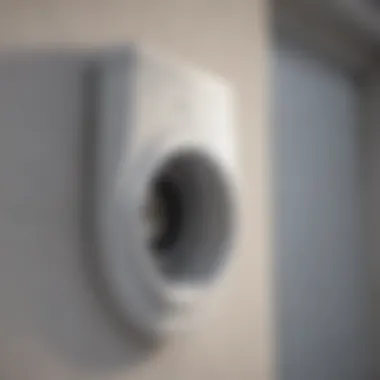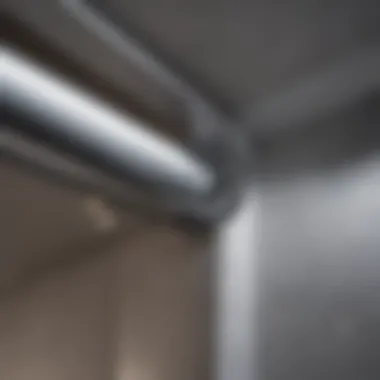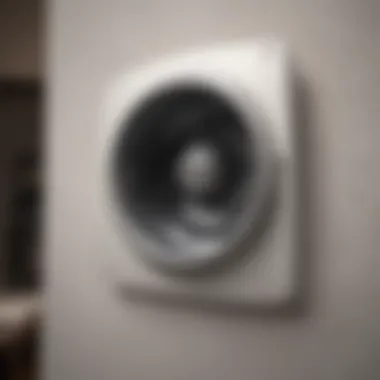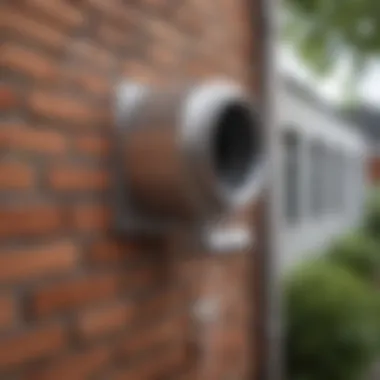A Comprehensive Guide on How to Properly Vent Your Dryer Outside


Inspiring Homes
If you happen to be in pursuit of the optimal way to efficiently vent your dryer to the outside, you've landed on the right page. Ventilation perfection with a blend of safety and efficacy is key during dryer operation. Understanding the nuances and significance of proper dryer venting is pivotal before embarking on the journey of installation and execution. Let's delve into the intricacies of outdoor dryer venting, unraveling the steps required to master this indispensable household task.
Introduction
Dryers are essential appliances in modern households, simplifying laundry tasks and expediting the drying process. However, the proper venting of dryers is often overlooked by many. This comprehensive guide focuses on the critical aspect of venting dryers outside, emphasizing safety and efficiency. By understanding the significance of correct venting methods and following the step-by-step instructions provided in this article, readers will gain valuable insights into optimizing their dryer's performance while ensuring safety.
Understanding the Importance of Proper Dryer Venting
When it comes to proper dryer venting, several key aspects contribute to the overall functionality of the appliance. First and foremost, preventing fire hazards is paramount. A clogged or inefficient dryer vent can lead to lint build-up and overheating, increasing the risk of fire within the home. By addressing this issue proactively, individuals can significantly reduce the potential for fire accidents and safeguard their property.
Enhancing dryer efficiency is another crucial element of proper venting. A well-vented dryer allows for optimal airflow, facilitating faster drying times and energy conservation. This not only improves the efficiency of the appliance but also contributes to cost savings in the long run. By channeling hot, moist air outside effectively, the dryer can operate at its peak performance levels, enhancing overall usability and convenience.
Protecting indoor air quality is a key consideration in proper dryer venting. Without adequate ventilation, dryers can release harmful gases and contaminants into the indoor environment, compromising air quality. By venting the dryer outside, individuals can maintain a healthy living space free from pollutants and allergens, promoting a comfortable and safe home environment.
Conclusion
Choosing the Right Venting Location
When considering how to properly vent a dryer outside, one crucial aspect to focus on is choosing the right venting location. This decision plays a significant role in the effectiveness and safety of the ventilation process. By selecting an optimal venting location, you can ensure proper airflow, reduce potential obstructions, and enhance the overall efficiency of your dryer. Whether you opt for an exterior wall or roof venting, each option comes with its unique benefits and considerations.
Exterior Wall vs. Roof Venting
When comparing exterior wall versus roof venting for your dryer, it's essential to weigh the pros and cons of each option to make an informed decision. Exterior wall venting is a popular choice for many homeowners due to its ease of installation and accessibility for maintenance. On the other hand, roof venting may offer better ventilation efficiency by utilizing the natural rising of warm air. However, it also requires careful planning to prevent leaks and ensure proper sealing.
Factors to Consider
In the selection process, several factors need consideration to determine the most suitable venting location for your dryer. Factors such as the proximity to the dryer unit, ease of access for cleaning and maintenance, and the structural integrity of the chosen venting pathway are crucial aspects to evaluate. Additionally, weather conditions, building codes, and aesthetic preferences can also influence your decision.


Exploring these factors in detail will enable you to make an informed choice that aligns with your specific needs and maximizing the efficiency of your dryer vent system. By understanding the benefits and considerations of exterior wall versus roof venting, you can take a step closer to achieving optimal dryer performance and safety standards.
Gathering the Necessary Tools and Materials
Venting a dryer outside necessitates the appropriate tools and materials to ensure a smooth and efficient process. The meticulous selection and gathering of these items are crucial for the success of the overall venting operation. By delving into this fundamental aspect of dryer venting, individuals can lay a strong foundation for a safe and functional ventilation system. Every tool and material has a distinct role to play in the process, underscoring the significance of this stage in the dryer venting journey.
Essential Tools
Dryer Vent Kit
The Dryer Vent Kit is a cornerstone element in the arsenal of tools required for effective dryer venting. Its primary function lies in facilitating the connection between the dryer and the exterior vent, ensuring a seamless airflow pathway. The key characteristic that sets the Dryer Vent Kit apart is its comprehensive nature, encompassing all essential components for a complete venting solution. This kit stands out as a popular choice for dryer venting due to its convenience and compatibility with various dryer models. The unique feature of the Dryer Vent Kit is its adaptability, allowing for easy installation and maintenance, simplifying the venting process for individuals of all skill levels.
Tape Measure
A Tape Measure serves as a precision tool indispensable for accurately measuring distances and dimensions during the venting process. Its key characteristic lies in its reliability and versatility, enabling individuals to mark out the optimal venting path with precision. The Tape Measure emerges as a beneficial choice for this article due to its role in ensuring the correct placement of vents and ductwork, essential for efficient dryer operation. A unique feature of the Tape Measure is its ease of use and portability, making it a practical tool for both amateur DIY enthusiasts and seasoned professionals alike.
Screwdriver
The Screwdriver plays a crucial role in securing components and fastening connections throughout the venting setup. Its key characteristic of versatility and durability makes it an essential tool for assembling the vent hood, ductwork, and other components. The Screwdriver's popularity stems from its universal applicability across a range of household projects, including dryer venting. A unique feature of the Screwdriver is its ergonomic design, enhancing grip and control during installation, although care should be taken to avoid over-tightening connections to prevent damage. While the advantages of using a Screwdriver in this context are numerous, individuals should exercise caution to prevent potential disadvantages, such as stripping screws or damaging components.
Step-by-Step Guide to Venting Your Dryer Outside
Venting your dryer outside is a critical aspect of home maintenance that often goes overlooked. Proper ventilation not only prevents fire hazards but also enhances dryer efficiency and protects indoor air quality. By following a comprehensive step-by-step guide, you can ensure your dryer operates safely and effectively, minimizing risks and optimizing performance.
Inspecting the Current Ventilation Setup
Checking for Blockages:
When inspecting your current ventilation setup, a key focus should be on checking for blockages. Blockages in the vent can hinder airflow, leading to potential overheating and fire risks. By thoroughly examining the vent for any debris, lint buildup, or foreign objects, you can mitigate these hazards and ensure optimal ventilation performance.


Evaluating Vent Condition:
Evaluating the condition of your vent is essential to maintaining a safe and efficient drying process. Damaged or worn-out vents can compromise the airflow, diminishing the dryer's effectiveness and posing safety concerns. Regularly assessing the vent's integrity and making necessary repairs or replacements will safeguard your home and appliances from potential risks.
Preparing the Venting Path
Choosing the Optimal Route:
Selecting the optimal route for venting your dryer outside is crucial for maximizing efficiency and safety. Factors such as the distance from the dryer to the exterior wall, the existence of obstructions, and structural considerations must be taken into account. By choosing a direct and unobstructed path, you can facilitate smooth airflow and minimize potential issues.
Clearing Obstructions:
Clearing obstructions along the venting path is imperative to ensure unrestricted airflow. Removing any obstacles, such as excess lint, debris, or obstacles blocking the vent opening, will prevent airflow restrictions and potential fire hazards. Maintaining a clear pathway for ventilation promotes efficient drying cycles and reduces the risks associated with blockages.
Installing the Vent Hood and Duct
Securing the Hood:
Securing the vent hood in place is a critical step in the installation process. The hood serves as the exterior termination point for the dryer vent, preventing backdrafts and outdoor elements from entering the vent system. Properly securing the hood ensures a tight seal and reliable protection against debris and weather conditions, maintaining optimal ventilation performance.
Connecting the Duct:
Connecting the duct from the dryer to the vent hood is a crucial component of the installation process. A secure connection between the duct and the hood eliminates leaks and ensures efficient airflow from the dryer to the exterior. Properly sealing the connection with duct tape or clamps prevents air leaks and enhances the overall safety and efficiency of the ventilation system.
Testing the Ventilation System
Checking for Proper Airflow:
After installing the vent hood and duct, it is essential to test the ventilation system for proper airflow. Adequate airflow is vital for efficient drying and preventing overheating issues. By assessing the airflow strength and consistency, you can verify that the ventilation system is functioning optimally and make any necessary adjustments for improved performance.


Verifying Secure Connections:
Once the ventilation system is in place, verifying secure connections is paramount to ensure long-term effectiveness. Double-checking the seals at the vent hood and duct connection points guarantees a tight fit and prevents air leaks. By confirming the stability of the connections, you can rest assured that your dryer is safely and efficiently vented to the outside.
Ensuring Safety and Maintenance
Safety and maintenance are paramount when it comes to dryer venting. Ensuring that your dryer vent system is in good condition not only prevents fire hazards but also promotes energy efficiency and extends the lifespan of your appliance. Regular maintenance is key to keeping your dryer running smoothly and safely. By following a few simple steps, you can make sure that your dryer vent remains clear of lint buildup and other blockages.
Regular Cleaning and Inspection
Removing Lint Buildup
One of the critical aspects of maintaining a safe dryer vent system is removing lint buildup. Lint is highly flammable and can cause a fire if allowed to accumulate in the vent duct. Regularly cleaning out lint ensures that airflow is not restricted, maximizing the efficiency of your dryer. Using a specialized lint brush or vacuum attachment, you can carefully remove lint from the vent duct, reducing the risk of fire and improving overall dryer performance.
Monitoring Vent Condition
Monitoring the condition of your vent is crucial for optimal dryer operation. Regular inspections can help you identify any damage, blockages, or leaks in the vent system. By checking for wear and tear, loose connections, or signs of obstruction, you can address issues promptly before they escalate. Monitoring the vent condition regularly helps in maintaining efficient airflow and reducing the chances of breakdowns or safety hazards. Being vigilant about the vent's condition ensures that your dryer works effectively and safely.
Conclusion
In the realm of effectively venting dryers outside, the conclusion serves as a crucial wrap-up, encapsulating the imperative facets of this enlightening guidebook. As we delve deeper into the benefits of proper dryer venting, it becomes evident that the conclusions drawn here are not merely endpoints but rather launching pads for enhanced safety, extended appliance lifespan, and improved energy efficiency. Understanding the intrinsic relationship between these pillars is key to mastering the art of dryer venting.
Benefits of Proper Dryer Venting
Enhanced Safety
Enhanced safety is the cornerstone of proper dryer venting practices and a linchpin in ensuring household safety and reducing fire hazards. By championing enhanced safety measures, individuals can preempt potential disasters, safeguarding against lint buildup and ensuring optimal airflow. This vigilance is the bedrock of a secure and protected indoor environment, where dryer performance is maximized without compromising on safety standards.
Extended Appliance Lifespan
Prolonging the lifespan of your appliances is a tangible benefit of proper dryer venting. Through meticulous adherence to venting guidelines, you not only promote the longevity of your dryer but also mitigate the risks of malfunctions and breakdowns. Extended appliance lifespan underscores the economic prudence of maintaining a well-vented dryer, where each cycle contributes to the appliance's durability and efficiency, ultimately translating into cost savings over time.
Improved Energy Efficiency
Embracing improved energy efficiency through proper dryer venting entails a twofold advantage: environmental and economic. By optimizing airflow and reducing energy wastage, individuals can curtail their carbon footprint while enjoying lower utility bills. The unique feature of improved energy efficiency lies in its sustainability quotient, offering a definitive edge to environmentally conscious consumers. This efficiency not only refines dryer performance but also signifies a conscientious step towards sustainable living practices, aligning with contemporary eco-friendly ideologies.



